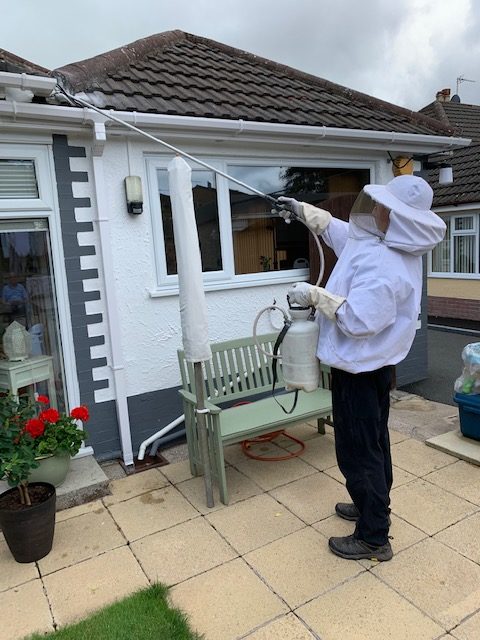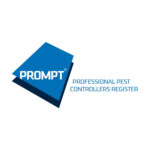Domestic Pest Control
Treating Problems with Rats, Mice, Wasp Nests, Bed Bug Infestations and More

Taking care of your pest problem
At some point in time your property may suffer from a pest infestation whether it be from wasps, ants, fleas, rats, mice or other pests. Often the first sign of a problem may be noises from the loft/attic, generally more noticeable at night when the home is quiet or ants on a kitchen work surface or around the bin or a wasp nest in your garden shed or bird box. All these issues need investigating by a professional pest control technician who will identify the cause, find any ingress points, provide an effective treatment, and advise you on the best cause of action.
For a no obligation quote or for advice please call Neil on 07971 196370 or 01257 260276
Pest Control Services Offered (but not limited to)
** Feral Honeybee only treated if danger to public. Can provide details of a Beekeeper for bee collection, call for details.
Annual service agreements for domestic properties offered. Please call for details. A callout fee may be payable if no treatment is required and/or advice only provided on visit to property. Prices will be lower if local to Chorley or Leyland but do I cover the whole of Lancashire and north west region please call for price in your area.
ALL PESTS COVERED
Please call for a quotation
07971 196370
or 01257 260276


Rats and Mice
Protection against rats is an important priority as rats destroy and contaminate foodstuffs, damage buildings and can spread disease. Damage by rats to the fabric of buildings can be costly. Fires have caused damage running to hundreds of thousands of pounds after a cable has been gnawed. Gas and water pipes are also at risk and rat burrowing can undermine foundations. Rats transmit diseases which are potentially fatal to man such as Weil’s disease and murine typhus. They also carry disease organisms such as Salmonella bacteria, viruses and parasites that can be harmful to people.
Look for the Signs
Domestic rat problems are often first noticed by sounds in the loft or basement but there are more signs to look out for to identify a rat problem:
Mice
Even though mice are similar to rats in many ways, they are a more common problem in houses because they live indoors and can enter a new location through gaps as small as 6mm. They are also more liable to cause fires by gnawing cables than rats and they carry diseases such as Salmonella. Mice also reproduce faster than rats which means that mice control needs to be tackled systematically.
Get a Free Quote
Lancashire Pest Control have 20 years of experience in many different environments and know exactly where to look for problems. We look for the root cause of the problem, advise on proofing measures and stop the problem happening in the future.
Call today to discuss how we can eradicate your rat problem or your mice problem:
07971 196370 or 01257 260276

Wasp Nests
Wasps are a temperate species that form nests in trees, soil banks, roof spaces and wall cavities. Their nests are formed of paper (chewed wood) and may become very large in size. Wasp colonies only survive a single season in the UK, new ones being started each spring by overwintered queens. They forage on a wide range of foods including spiders, insects and sweet substances. Wasps may become aggressive if threatened.
Common and German wasps are common throughout the UK and Northern Europe. They are social insects forming colonies inside of nests specially constructed in roofs, soil banks, tree cavities and walls. They are frequently associated with domestic housing where food can often be found.
With the onset of cooler weather, the workers and the few remaining males become sluggish, and their feeding on ripe and over-ripe fruit can produce a “tipsy” behaviour, leading to aggression towards anyone interfering with them. The onset of the cold winter weather kills off all the workers and the males, with only the fertilised queens surviving individually in hibernation to start new colonies in the following spring.
Old nests are not re-used although in favourable sites, a new nest may be built in close proximity to an old one.
Wasps can inflict a painful sting, a habit which increases as the insects become more irritable with the onset of cooler weather and the ingestion of fermenting, over-ripe fruit juices.
Wasp control should be dealt with by a professional pest control technician for safety reasons. Please contact Neil at Lancashire Pest Control to carry out treatment/removal of a wasp nest at your property.
Solitary and mason bees are unlikely to be confused with common or German wasps. Their colouration is similar to the honey bee and quite frequently they are associated with buildings. They prefer to make their nests in suitable cavities in buildings and will even excavate soft mortar from brickwork to make their individual nests. These can be controlled as per wasps nests.

House Moths
Widespread throughout the northern hemisphere, brown house moths are common in most European countries, including the UK. Frequently in domestic premises but rarely of great significance. Brown house moths are occasionally a pest but only cause damage in their larval stage.
Brown house moths are widespread and common in food stores and domestic environments. It is only the larva of the moth which feeds and causes damage, and its cryptic habits make careful examination of likely resting and feeding site necessary.
The common clothes moth is a moderately common pest of animal derived fabrics, feather and fur products. They are found world wide except for in the tropics and also only cause damage during their larval stage. It is a common indoor insect throughout Britain and most of the world. To control it, good hygiene is recommended along with residual sprays and dichlorvos strips in enclosed spaces, such as wardrobes and cupboards.
The case bearing clothes moth is a species similar to the common clothes moth, with the larvae feeding on particles of woollen clothing, furniture fillings, carpets and furs, primarily of natural animal origin.

Carpet Beetles
Carpet beetles are classed as Dermestidae (skin feeders). Adult carpet beetles are 2-4mm in legnth, have a strong convex body and their colours vary from brown or black and mottled with yellow or white scales on the dorsal surface. Their larvae are brown, bearing 3 bunches of golden hairs on the tip of the abdomen.
The species is a pest of animal products and occasionally food products of plant origin also. Consequently they may be found wherever these commodities are handled or stored. Carpet beetles are now one of the major pests of textiles with their success being attributed to central heating, which ensures uniform temperatures, and the increasing use of wall-to-wall carpeting, which allows the insects to breed undisturbed. They prefer warm, dry conditions as they are ideal for their development.
Adult carpet beetles live outdoors on pollen and nectar, taken in particular from Umbelliferae and Spiraes. They can also be found wandering on walls and windows. In temperate climates the larvae are particularly evident in the autumn when they wander in search of food and hibernation sites. Carpet beetles thrive in situations where they remain undisturbed, for example around skirting boards, in wardrobes and under carpets. Rodent and bird nexts, dead insects and animal remains are frequent reservoirs of infestation.
Larval forms can cause considerable damage to keratin containing products such as fur, leather, silk, wool and dried animal remains. Occasionally, food products of plant origin, such as fibres and cereals will also be attacked.

Ants
In Britain comparatively few indigenous species, which nest outdoors, are likely to enter houses regularly. One such species is the Common Black Ant (Lasius niger).
An active insect, it nests outside in grass and walls and under paving. It will forage widely in search of food, which is how it comes to enter domestic premises.
Foraging worker ants cause a nuisance as they travel widely in search of food, following well defined trails and clustering around the food source. Sweet foods are preferred.
The gregarious habits of ants have resulted in the development of a caste system, whereby individuals are responsible for specialised duties
within the community. There are: workers (sterile females); fertile males; and queens (fertile females). The worker ants build and extend the nest, look after larval forms and forage for food, whereby they become pests.
Although frequently inaccessible and difficult to destroy, ants’ nests must be eradicated if infestations are to be successfully controlled. The nests of black ants can be located by following their trails. Potential food sources should be identified and protected from attack.

Cockroaches
In the UK, there are two types of common cockroach. The Oriental cockroach, and the German cockroach.
Adult Oriental cockroaches are 20-24mm long and are dark-brown, nearly black in colour. The wings of male cockroaches cover two-thirds of their abdomen, the wings of the females are vestigial. Oriental cockroaches can climb rough but not smooth vertical surfaces.
Adult German cockroaches are 10-15mm long and are yellowish-brown in colour with two longitudinal dark marks on pronotum. Their wings are well developed in both sexes. German cockroaches can readily climb rough and polished vertical surfaces.
Cockroaches are common in commercial premises associated with the production or handling of food. Also in public buildings and domestic premises, for example, apartment blocks. Gregarious and nocturnal, they spend the day hiding in cracks and crevices around such areas as cookers, sinks, drains, the backs of cupboards and in refrigerator motor compartments. They especially favour buildings with service ducts and complex plumbing installations.
An assessment of the infestation must be made to determine the species and extent of the infestation. Plans of the area will be required. The entire site should be inspected, including where appropriate adjoining premises, normally inaccessible places, drains etc. A high standard of hygiene is important in the control of cockroaches.

Cat and Dog Fleas
Dog and cat fleas are another common pest found in the UK and throughout the world. In Europe fleas are not generally responsible for the transmission of disease. However, they are still objectionable because of the bites they inflict and the deep-rooted social stigma attached to humans with flea infestations.
Flea bites are identified as a tiny dark red spot surrounded by a reddened area. The bite persists for one or two days and is intensely irritating. Adult fleas are stimulated to emerge by the vibrations set up by a passing host. This explains the occasional mass attacks which take place in many domestic premises.
Regular cleaning will deny the insects their breeding site and so make an important contribution towards their control. Infested clothing, beds and bedding should be destroyed by burning or thoroughly cleaned and the same measures employed when dealing with old bird and animal nests. Accumulations of debris should also be removed from cracks and crevices such as the cracks between floorboards, and the whole area thoroughly cleaned.

Bedbug Infestation
Bedbugs are very small insects that often live on furniture, clothing or bedding and their source of nourishment is human blood. Their bites can be itchy and there may be painful swelling due to an inflammation caused by an allergic reaction to their saliva.
In the UK bedbugs have increasingly become a problem but it is not easy to identify or even know that there is a problem. Bedbugs are averse to any light source and not all people have a reaction to their bites.
Look for the Signs
It is important to act as soon as possible after identifying a bed bug problem. Please call and get advice.
07971 196370 or 01257 260276
Testimonials
I would highly recommend Lancashire Pest control, I have used their services on many occasions due to an on going rat problem.
I have always found Neil to be prompt and incredibly knowledgeable. He is an expert in his field and his advice and services have been excellent.
I always recommend Lancashire Pest Control to anyone with pest control issues , you will not be disappointed. 5 star service.
FANTASTIC FAST SERVICE
I would have no hesitation to recommend Lancashire Pest Control. I had an issue with a mouse infestation. Neil came out straightaway and was clearly an expert in his field. He found where they were getting in then lay traps in points throughout the house. Neil was also was aware to set the traps in areas out of reach from my young daughter. The mice haven’t been seen since and Neil has been back in touch to check up and collect the traps. Excellent service I would use Lancashire Pest Control again for any pest related issue.
More than happy with your service, not sure the wasps would agree though.
